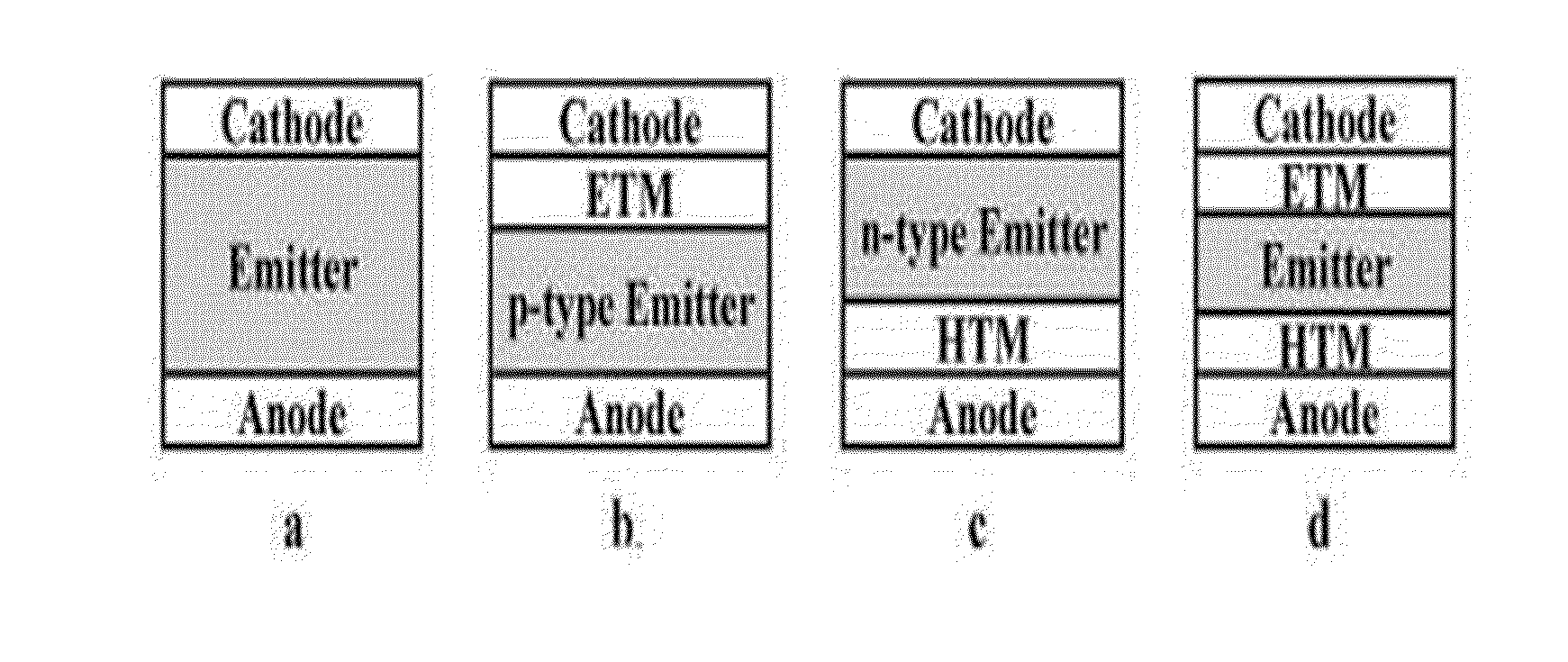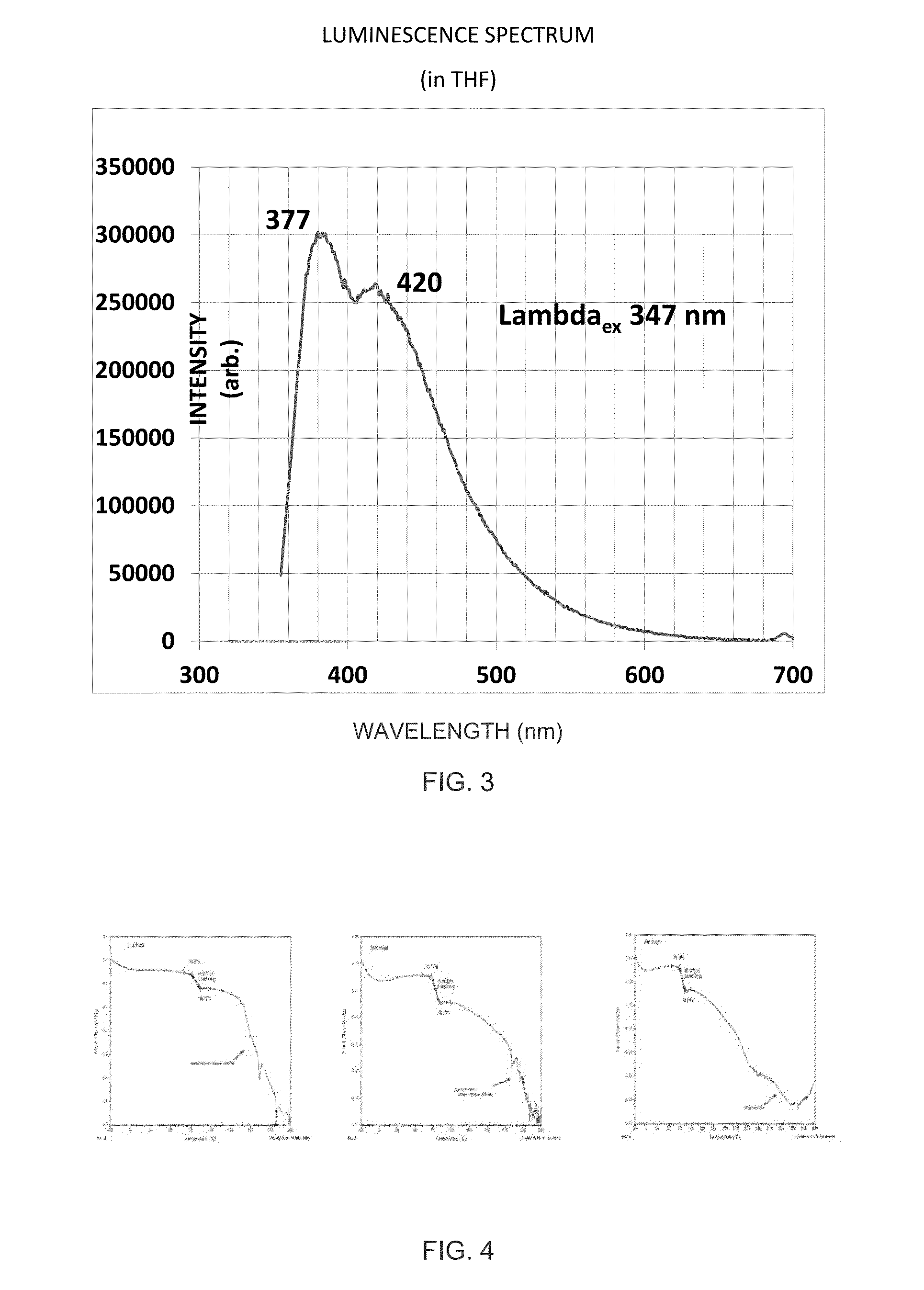Charge-transporting Molecular Glass Mixtures, Luminescent Molecular Glass Mixtures, or Combinations Thereof for Organic Light Emitting Diodes and other Organic Electronics and Photonics Applications
- Summary
- Abstract
- Description
- Claims
- Application Information
AI Technical Summary
Benefits of technology
Problems solved by technology
Method used
Image
Examples
example 1
Bipolar Carbazole-Oxadiazole Molecular Glass Mixture
[0348]
TABLE 2Optical, Photophysical PropertiesMolecularμelectronμholeGlass Mixtureλabsa / nmλabsb / nmλemc / nmEcg / evEdg / evcm2 / Vseccm2 / VsecExample 1333 / 348377 / 420 (347 ex)3.43Example 2238 / 265 / 296240 / 285 / 320368 (295 ex)3.433.294.8 × 10−44.8 × 10−4aIn THFbNeat Filmcin THFdNeat Film
TABLE 3Thermal PropertiesMolecular Glass MixtureTge / ° C.Tsch / ° C.Tm / ° C.Td / ° C.Example 180nonenone275Example 2150202.7291.6320e) @ 10° / min
[0349]Thermal Properties
[0350]Referring to the graph depicted in FIG. 4, differential scanning calorimetry (DSC), shows no crystallization peak (Tsch), no melting point peak (Tm), and a well defined glass transition temperature (Tg) at 80° C. even after four heating cycles up to 200° C. above the glass transition temperature. This clearly shows that the molecular glass mixture is noncystallizable. The Tg of this molecular glass mixture (80° C.) is 15° C. above that of TPD (N,N′-diphenyl-N,N′-bis-3-methylphenyl[1,1′-bipheny]-4,4...
example 2
Bipolar Oxadiazole-Carbazole 3,3′,4,4′-Biphenyltetracarboxilic Bisimide Molecular Glass Mixture
[0363]Solubility
[0364]The molecular glass mixture is soluble in tetrahydrofuran (THF), N-methyl pyrrolidone (NMP) and dichloromethane (DCM), slightly soluble in toluene and insoluble in acetone.
[0365]Photophysical Properties
[0366]The UV / Vis spectrum in THF has three peaks at 238, 265, and 296 nm. The optical band gap (Eg) was calculated from the threshold of THF solution optical absorption at 3.43 eV. The fluorescence emission spectrum in THF (Eext, 295 nm) shows a lambda max at 368 nm. The optical band gap (Eg) was calculated from the threshold of thin film optical absorption on quartz at 3.29 eV. These are depicted in Table 2.
[0367]Charge Transport Mobility
[0368]Time-of-flight (TOF) measurements show bipolar charge transport. Electron and hole mobility (μelectron and μhole, respectively) was estimated at 4.8×10−4 cm2 / Vsec, as depicted in Table 2. The 1.5 micron film used for the TOF meas...
PUM
| Property | Measurement | Unit |
|---|---|---|
| Temperature | aaaaa | aaaaa |
| Electric charge | aaaaa | aaaaa |
| Transport properties | aaaaa | aaaaa |
Abstract
Description
Claims
Application Information
 Login to View More
Login to View More - R&D
- Intellectual Property
- Life Sciences
- Materials
- Tech Scout
- Unparalleled Data Quality
- Higher Quality Content
- 60% Fewer Hallucinations
Browse by: Latest US Patents, China's latest patents, Technical Efficacy Thesaurus, Application Domain, Technology Topic, Popular Technical Reports.
© 2025 PatSnap. All rights reserved.Legal|Privacy policy|Modern Slavery Act Transparency Statement|Sitemap|About US| Contact US: help@patsnap.com



